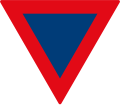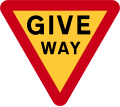Yield sign
Traffic sign From Wikipedia, the free encyclopedia
In road transport, a yield or give way sign indicates that merging drivers must prepare to stop if necessary to let a driver on another approach proceed. A driver who stops or slows down to let another vehicle through has yielded the right of way to that vehicle. In contrast, a stop sign requires each driver to stop completely before proceeding, whether or not other traffic is present. Under the Vienna Convention on Road Signs and Signals, the international standard for the modern sign is an inverted equilateral triangle with a red border and either a white or yellow background. Particular regulations regarding appearance, installation, and compliance with the signs vary by some jurisdiction.

Terminology
Summarize
Perspective
While give way and yield essentially have the same meaning in this context, many countries have a clear preference of one term over the other. The following table lists which countries and territories use which term. This chart is based on official government usage in the English language and excludes indirect translations from other languages.
Areas where give way is used
 Anguilla
Anguilla Antigua and Barbuda
Antigua and Barbuda Australia
Australia The Bahamas
The Bahamas Bahrain
Bahrain Bangladesh
Bangladesh Barbados
Barbados Bermuda
Bermuda Bhutan
Bhutan Brunei
Brunei Cayman Islands
Cayman Islands Cyprus
Cyprus Dominica
Dominica Egypt
Egypt Falkland Islands
Falkland Islands Fiji
Fiji The Gambia
The Gambia Ghana
Ghana Gibraltar
Gibraltar Grenada
Grenada Guernsey
Guernsey Guyana
Guyana Hong Kong SAR
Hong Kong SAR India
India Isle of Man
Isle of Man Israel
Israel Jamaica
Jamaica Jersey
Jersey Jordan
Jordan Kenya
Kenya Kiribati
Kiribati Kuwait
Kuwait Malawi
Malawi Malaysia
Malaysia Maldives
Maldives Malta
Malta Mauritius
Mauritius Montserrat
Montserrat Nauru
Nauru Nepal
Nepal New Zealand
New Zealand Nigeria
Nigeria Pakistan
Pakistan Papua New Guinea
Papua New Guinea Philippines
Philippines Qatar
Qatar Rwanda
Rwanda Saint Kitts and Nevis
Saint Kitts and Nevis Saint Lucia
Saint Lucia Saint Vincent and the Grenadines
Saint Vincent and the Grenadines Samoa
Samoa Seychelles
Seychelles Singapore
Singapore Solomon Islands
Solomon Islands Sri Lanka
Sri Lanka Tanzania
Tanzania Thailand
Thailand Tonga
Tonga Trinidad and Tobago
Trinidad and Tobago Turks and Caicos
Turks and Caicos Tuvalu
Tuvalu Uganda
Uganda United Arab Emirates
United Arab Emirates United Kingdom
United Kingdom Vanuatu
Vanuatu Zambia
Zambia Zimbabwe
Zimbabwe
Areas where yield is used
History

A black triangle (within the standard down-arrow-shape of stop signs) was a symbol of "stop for all vehicles" from about 1925 in Germany. The triangular yield sign was used as early as 1937, when it was introduced in Denmark in red and white (matching the Danish flag),[1] in 1938 when it was codified in Czechoslovakia in a blue-white variant without words,[2] and in 1939 in the Protectorate of Bohemia and Moravia which adopted the current red-white variant.[3] In the United States, the first yield sign was erected in 1950 in Tulsa, Oklahoma, designed by Tulsa police officer Clinton Riggs;[4][5] Riggs invented only the sign, not the rule, which was already in place.[6] Riggs' original design was shaped like a keystone; later versions bore the shape of an inverted equilateral triangle in common use today. The inverted equilateral triangle was then adopted by the Vienna Convention on Road Signs and Signals as the international standard.
Country specifics
Summarize
Perspective

Australia
In Australia, the Give Way sign evolved similarly to its counterpart in the United States. During the 1940s and 1950s, the sign was a yellow circle. In 1964, the sign changed to a red triangle. In the 1980s, the sign adopted its modern design and gained a counterpart for use at roundabouts.
- Original design (1940–1964)
- Second version (1964–1974)
- Modern design since 1974
Ireland
In Ireland, the yield sign reads yield in most areas, although in Gaeltacht (Irish-speaking) areas the text is géill slí ("yield right of way"[7]) instead.[8][9] Signs erected between 1962 and 1997 read yield right of way,[10] which remains legally permitted.[9] Signs 1956–1962 had a blank white interior.[11]
- 1956–1962
- 1962–1997
- English-language version (1997 – present)
- Irish-language version (1962 – present)
New Zealand
In New Zealand, the original design also used the keystone shape as in the United States but used a black background with a red border. In the 1980s, the modern design was adopted. On sealed roads, the give way sign is always accompanied by a white line painted on the road to clarify the rule to road users even if the sign is obscured or missing.[12]
- Original design (1964–1987)
- Modern design since 1987
United Kingdom



The United Kingdom's Road Traffic Act calls for give way signs and road markings at junctions (crossroads) where the give-way rule is to apply. The road marking accompanying the sign consists of a large inverted triangle painted just before the place to give way, which is marked by broken white lines across the road.[13]
In Wales, some signs bear a bilingual legend: the Welsh ildiwch appears above give way.
In the United Kingdom, a stop or give-way sign may be preceded by an inverted, blank, triangular sign with an advisory placard such as give way 100 yards.[14]
United States
In the Federal Highway Administration's Manual on Uniform Traffic Control Devices, a yield sign may be warranted[15]
"if engineering judgment indicates that one or more of the following conditions exist:
- When the ability to see all potentially conflicting traffic is sufficient to allow a road user traveling at the posted speed, the 85th-percentile speed, or the statutory speed to pass through the intersection or to stop in a reasonably safe manner.
- If controlling a merge-type movement on the entering roadway where acceleration geometry and/or sight distance is not adequate for merging traffic operation.
- The second crossroad of a divided highway, where the median width at the intersection is 30 ft or greater. In this case, a STOP sign may be installed at the entrance to the first roadway of a divided highway, and a YIELD sign may be installed at the entrance to the second roadway.
- An intersection where a special problem exists and where engineering judgment indicates the problem to be susceptible to correction by the use of the YIELD sign."
The sign went through several changes from its original design to the sign used today. Originally invented in 1950 and added to the MUTCD in 1954, the sign used the "keystone" shape before adopting the more readily recognized triangular shape. In 1971, the sign evolved into its modern version and changed from yellow to red, paralleling the same change that had earlier been made by STOP signs.
- Early design (1950–1954)
- Second version (1954–1961)
- Third version (1961–1971)
- Modern design as agreed to in 1971
Other countries

- Most countries around the world use a red and white inverted triangle with no text.
- Cuba, Finland, Greece, Iceland, Kuwait, Nigeria, Poland, Sweden and Vietnam use a red and yellow version of the sign.
- United Kingdom, British Overseas Territories and Crown Dependencies, Bhutan and most Commonwealth nations use a version of the sign that reads give way.
- Dominica, Fiji, Liberia, New Zealand, and Samoa display text in red.
- Singapore places the sign inside a white round square.
- Belize, Brazil, Canada and Romania use a much thicker red border.
- Argentina, Bolivia, Colombia, Costa Rica, Dominican Republic, Ecuador, El Salvador, Mexico, Nicaragua, Panama, Paraguay, Peru, Uruguay and Venezuela use ceda el paso.
- Puerto Rico uses a version of the American sign translated into Spanish which reads ceda.
Gallery
- International standard with white background (most countries around the world use this version)
- International standard with yellow background (Finland, Greece, Iceland, Kuwait, Poland, Sweden, Vietnam)
- Belize, Brazil, Canada, Romania
- SACU standard (Botswana, Eswatini, Lesotho, Namibia, South Africa) (no longer used, the blue background has since been phased out in favour of white)
Signs with text in English
- Anglophone Africa, Anglophone Caribbean (Lesser Antilles), India, Mauritius, Seychelles, United Kingdom
- Australia, Guyana, Papua New Guinea, Vanuatu
- Dominica
- Fiji, New Zealand, Samoa
- Ireland
- Jamaica
- Liberia
- Nigeria
- Singapore
- Tonga
- United States
Signs with text in Spanish
- Argentina
- Central America
- Colombia
- Cuba
- Ecuador
- Mexico
- Mexico (Jalisco)
- Mexico (no longer used)
- Panama
- Peru
- Puerto Rico
Signs with text in French
- Algeria, Djibouti, Tunisia
- Canada (Ontario)
- France, Francophone Africa, Monaco
- France (Brittany)[16]
- Haiti
- Mauritania and Morocco
Signs with text in other languages
- Brunei
- China
- Taiwan
- Hong Kong
- Ireland (Gaeltacht)
- Malaysia
- Maldives
- Philippines
- Qatar
- South Korea
- Thailand
- United Arab Emirates
- Wales
See also
References
External links
Wikiwand - on
Seamless Wikipedia browsing. On steroids.





















































